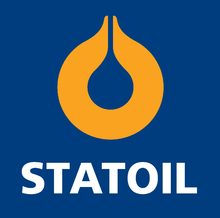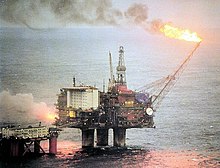Equinor
| Equinor ASA
|
|
|---|---|
| legal form | Corporation |
| ISIN | NO0010096985 |
| founding | October 1, 2007 |
| Seat |
Stavanger , Norway |
| management |
|
| Number of employees | 23,300 (2016) |
| sales | 465 billion crowns (2015) (about 49 billion euros ) |
| Branch | Petroleum and natural gas |
| Website | www.equinor.com |
The Equinor ASA (until 2018: Statoil ASA until 2009: StatoilHydro ASA ), was created from the merger of Statoil and especially the oil - and gas activities of Norsk Hydro , and is a publicly traded oil and gas company based in Stavanger , whose Majority with 67% is held by the Norwegian state. Equinor employs around 21,300 people, including around 19,000 in Norway, making it Norway's largest company. In 2015, the company had total sales of NOK 465.3 billion (around EUR 49 billion).
In the Forbes Global 2000 of the world's largest companies, Equinor ranks 91st (as of FY 2017). The company had a market value of over USD 90 billion in early 2018.
Business areas
Upstream activities
Statoil is the largest operator on the Norwegian continental shelf with 60% of total production . The fields worked are Glitne, Gullfaks , Heidrun, Huldra, Kristin, Kvitebjørn, Mikkel, Norne, Ormen Lange, Sleipner, Snorre, Snøhvit , Statfjord , Sygna, Tordis, Troll, Veslefrikk, Vigdis, Visund, Volve and Åsgard. The company also has processing plants at Kolsnes, Kårstø, Mongstad, Tjeldbergodden and Melkøya .
In addition to the Norwegian continental shelf, Statoil operates oil and natural gas fields in Algeria, Angola, Azerbaijan, Brazil, Canada, China, Iran, Libya, Nigeria, Russia, the United States and Venezuela. Statoil has offices looking for business opportunities in Egypt, Mexico, Qatar and the United Arab Emirates. The company has processing plants in Belgium, Denmark, France and Germany.
In 2006 Statoil received the approval to implement the world's largest project for CO 2 capture and storage (CCS). In the process, carbon dioxide emissions ( greenhouse gases ) are deposited under the earth's surface in order to reduce global warming .
Midstream activities
Statoil is involved in a number of pipeline transports , including Zeepipe , Statpipe, Europipe I and Europipe II as well as Franpipe from the Norwegian continental shelf to Western Europe in addition to the Baku-Tbilisi-Ceyhan pipeline in Central Asia . The pipelines of Norway are organized by "Gassled".
The company has offices trading crude oil, refined petroleum products and natural gas liquids in London , Stamford and Singapore .
Downstream activities
The downstream business segment (filling station network) was spun off as an independent company Statoil Fuel & Retail in 2010 .
Wind energy
Equinor owns and operates the 30 MW Hywind Scotland wind farm 29 kilometers off Peterhead, Scotland. Equinor holds 50% of the shares in the Polish 1,200 MW offshore wind farms Baltyk Srodkowy III and Baltyk Srodkowy II. It also holds 50% of the shares in the 385 MW Arkona wind farm off the German coast. Equinor operates the Sheringham Shoal offshore wind farm with a 40% stake in the project and holds 50% stake each in the wind farms Creyke Beck A and B and Teesside A of the offshore wind farm Dogger Bank near Great Britain.
history
On June 14, 1972, by resolution of the Storting , the Norwegian Parliament, Den norske stats oljeselskap ( Oil Company of the Norwegian State ), Statoil for short, was founded. The aim was to participate in the exploitation of the oil deposits discovered in the North Sea in the 1960s and to form the basis for a national oil industry ( refineries , petrochemicals ). The founding paragraph stipulates that Statoil should deal with the extraction, transport, distribution and sales of petroleum and products derived from it. In addition, an extensive reporting obligation to the Ministry of Industry (later the Ministry of Oil and Energy ) was set.
Preparations for oil production soon began, and in 1974 the Statfjord field was discovered on the Norwegian continental shelf . Production started in 1979 - initially, the crude oil was transported ashore by ship from the drilling platform .
In 1981 Statoil was the first Norwegian company to take sole operational responsibility for a new field: Gullfaks in the south of the continental shelf.
Another step in diversification followed in 1985 when the Norwegians took over the Scandinavian petrol station network of their competitor Esso . Today the Statoil Detaljhandel petrol station division is the market leader in several Northern European countries.
The group has also been producing natural gas since 1988 (the first natural gas field to be developed was Tommeliten ), and in the same year, Mongstad (near Bergen ), the second largest crude oil loading terminal in Europe, was opened. At the same time, the expansion of extraction activities began (it is assumed that the Norwegian continental shelf has already passed its production peak and there are hardly any large new oil fields to be found there): branches in China and Angola were last opened in 2005 . Statoil's German headquarters are in Emden an der Knock , where a landing and cleaning station for North Sea gas is also operated.
Partial privatization took place in 2001: 18 percent of the shares were sold on the Oslo Stock Exchange , and Statoil is now also listed on the New York Stock Exchange .
In 2007 the "Oil & Energy" division of the second largest Norwegian oil company Norsk Hydro was merged with Statoil. Norsk Hydro brought in its oil and gas division Hydro Agri . The new company Statoil should be able to assert itself more successfully in the international market against the other globally operating oil companies. This step had been under discussion for years, but became acute again in October after the failure of talks between both Statoil and Norsk Hydro with the Russian government about participation in the gigantic Shtokman gas field . The current Statoil boss Helge Lund became the chairman of the board of the new company, the current Norsk Hydro boss Eivind riding became the chairman of the supervisory board . Norsk Hydro's hydropower and aluminum activities remained independent. The crude oil and natural gas business and activities in the field of renewable energies such as wind energy , biodiesel and hydrogen technology were merged .
In the course of the conversion from a gas and oil company to an energy company also in other sectors, the company was renamed Equinor ASA on May 15, 2018 . With the name change, the company wanted to shed its image as an oil company. Equinor sounds like equilibrium, like balance, according to a statement by the company boss.
Crises and scandals
Statoil's history has not always been successful. In the first few years in particular, the company made billions in losses as a result of expensive acquisitions and a lack of experience in the oil business.
On August 23, 1991, a new drilling rig sank in the Sleipner A production field due to a design fault . Funding could only be started in 1993 and the ecological consequences of this accident cannot be precisely foreseen to this day.
Over the years Statoil was repeatedly involved in criminal proceedings, as accidents at work on drilling platforms often cost human lives or oil spilled into the North Sea. The group was sentenced to high fines several times. In 2002, the largest corruption scandal in Norwegian economic history involving Statoil was uncovered, which involved covert payments in Iran . Since February 2005, the company is under close observation by the US Securities and Exchange Commission SEC .
In Ireland, Shell (in cooperation with Statoil and Marathon ) is planning to build a land-based refinery for natural gas from the Atlantic against the will of the local population. The residents of the remote area fear the destruction of their environment and their livelihoods. One group is resisting the project under the name Shell to sea . In May 2007, local resident and activist Willie Corduff was awarded the Goldman Environmental Prize for his work.
A plant on the island of Melkøya near Hammerfest , in which natural gas is liquefied and transported to the mainland by ship, was shut down again in November after it started in August 2007 due to technical problems. In the meantime, some of the gas has been flared off, releasing significant amounts of carbon dioxide, nitrogen oxides and carcinogenic soot into the environment. At the end of January 2008, part of the plant is to go into operation, with excess gas then being flared off again.
On January 16, 2013, Malian Islamic militants kidnapped nine foreigners in Algeria in one of the company's oil fields. The attackers had attacked the Tiguentourine gas plant , which is operated jointly with BP and the Algerian energy company Sonatrach .
Web links
- Homepage of Equinor
- Map with the Statoil production areas in the North Sea
- Norwegian Petrolium Directorate Detailed information on the individual fields on the Norwegian continental shelf
- “It can also go well” Report on Statoil and the search for oil and gas, by Matthias Hannemann, brand eins 06/2012
Individual evidence
- ↑ a b Employees of Statoil '. statoil.com, accessed on March 29, 2016 (English).
- ↑ a b Statoil sales by 2015 '. finanzen.net, accessed on March 29, 2016 .
- ^ Investors - analyst and financial information - equinor.com. Retrieved June 21, 2019 .
- ^ The World's Largest Public Companies . In: Forbes . ( forbes.com [accessed July 17, 2018]).
- ↑ Floating wind farm to be UK first . November 2, 2015 ( bbc.com [accessed October 29, 2019]).
- ↑ Statoil enters offshore wind in Poland - equinor.com. March 5, 2018, accessed October 29, 2019 .
- ↑ E.ON and Statoil to Jointly Build 385MW Arkona Offshore Wind Farm. In: offshorewind.biz. April 25, 2016. Retrieved October 29, 2019 (American English).
- ↑ Revised ownership structure in UK offshore wind project - equinor.com. Retrieved October 29, 2019 .
- ↑ Statoil ASA changes name to Equinor ASA , at www.equinor.com , accessed on May 19, 2018
- ^ Die Zeit, August 9, 2018, p. 31.
- ↑ Gas torch promotes ice melt , taz article from January 24, 2008
- ^ Raid in Algeria: Islamists raid BP gas field and take hostages , accessed on January 16, 2013



